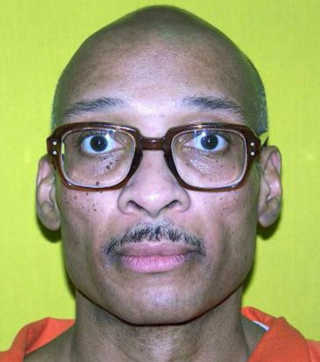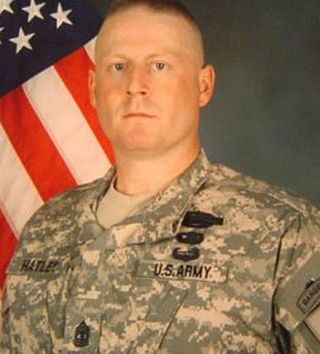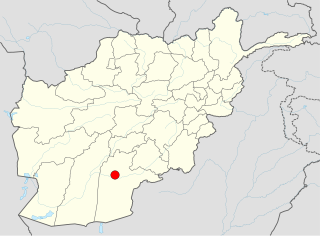Fort Cavazos is a United States Army post located near Killeen, Texas. The post is named after Gen. Richard E. Cavazos, a native Texan and the US Army’s first Hispanic four-star general. Formerly named Fort Hood for Confederate General John Bell Hood, the post is located halfway between Austin and Waco, about 60 mi (97 km) from each, within the U.S. state of Texas. The post is the headquarters of III Armored Corps and First Army Division West and is home to the 1st Cavalry Division and 3rd Cavalry Regiment, among others.

Fragging is the deliberate or attempted killing of a soldier, usually a superior, by a fellow soldier. U.S. military personnel coined the word during the Vietnam War, when such killings were most often committed or attempted with a fragmentation grenade, to make it appear that the killing was accidental or during combat with the enemy. The term fragging now encompasses any deliberate killing of military colleagues.

The United States Disciplinary Barracks (USDB), colloquially known as Leavenworth, is a military correctional facility located on Fort Leavenworth, a United States Army post in Kansas. It is one of two major prisons built on Fort Leavenworth property, the other is the military Midwest Joint Regional Correctional Facility, which opened on 5 October 2010. It reports to the United States Army Corrections Command and its commandant usually holds the rank of colonel.

The 325th Infantry Regiment is an infantry regiment of the 82nd Airborne Division. The regiment serves as the 82nd Airborne's light infantry parachute insertion fighting force of the United States Army, with a long and distinguished history, having taken part in World War I, World War II, the Vietnam War, the invasions of Grenada and Panama, as well as the Gulf and Iraq Wars. The subordinate units of the regiment constitute the bulk of the infantry elements assigned to the 2nd Infantry Brigade Combat Team, 82nd Airborne Division.
About one to two percent of United States Armed Forces members are estimated to belong to criminal gangs in the United States, a much higher proportion than in the civilian population.

Michael (Stewart) Waddington is an American criminal defense lawyer specializing in court-martial cases, war crimes, and other serious felonies. He defended Sgt. Alan Driver, accused of abusing detainees, and Specialist Hunsaker in the Operation Iron Triangle Case.

The 30th Armored Brigade Combat Team is a modular heavy brigade of the United States Army National Guard. 30th ABCT relieved 3rd ABCT/4ID in Kuwait, 1 November 2019. They returned to the U.S. in September 2020 and were replaced by the 2nd ABCT/1AD.

Ronald Adrin Gray is an American serial killer and rapist whose convictions include four counts of murder, one count of attempted murder and eight counts of rape. His crimes were committed when he was in the United States Army, stationed at Fort Bragg, North Carolina.

The deaths of Phillip Esposito and Louis Allen occurred on June 7, 2005, at Forward Operating Base Danger in Tikrit, Iraq. Captain Phillip Esposito and First Lieutenant Louis Allen, from a New York Army National Guard unit of the United States 42nd Infantry Division, were mortally wounded in Esposito's office by a Claymore mine and died.

John E. Hatley is a former first sergeant who was prosecuted by the United States Army in 2008 for murdering four Iraqi detainees near Baghdad, Iraq in 2006. He was convicted in 2009 and sentenced to life in prison at the Fort Leavenworth Disciplinary Barracks. He was released on parole in October 2020. Hatley is colloquially associated with a group of US military personnel convicted of war crimes known as the Leavenworth 10.
On May 11, 2009, five United States military personnel were fatally shot at a military counseling clinic at Camp Liberty, Iraq by Army Sergeant John M. Russell. In the days before the killings, witnesses stated Russell had become distant and was having suicidal thoughts.

Michael Chase Behenna is a former United States Army First Lieutenant who was convicted of the 2008 murder of Ali Mansur Mohamed during the occupation of Iraq. Behenna is colloquially associated with a group of U.S. military personnel convicted of war crimes known as the Leavenworth 10. He was sentenced to 25 years imprisonment, which was later reduced to 15 years, and served his sentence in the United States Disciplinary Barracks on Fort Leavenworth, a United States Army post in Kansas. He was granted parole on March 14, 2014, after serving less than five years of his sentence. Since his release from prison he has worked as a farmhand. On May 6, 2019, Behenna received a pardon from President Donald Trump.

Forward Operating Base Sarkari Karez was a foreign military base in Maywand District, Kandahar Province, Afghanistan. The base was initially established, secured and named by the 2nd Battalion, 2nd Infantry "Ramrods" in 2008. It was built by the Bravo Company, 62nd Engineer Battalion based in Fort Hood. After President Barack Obama expanded the US presence in Afghanistan, several thousand U.S. Army soldiers were stationed at the base.

The Maywand District murders were the thrill killings of at least three Afghan civilians perpetrated by a group of U.S. Army soldiers from January to May 2010, during the War in Afghanistan. The soldiers, who referred to themselves as the "Kill Team", were members of the 3rd Platoon, Bravo Company, 2nd Battalion, 1st Infantry Regiment, and 5th Brigade, 2nd Infantry Division. They were based at FOB Ramrod in Maiwand, in Kandahar Province of Afghanistan.
United States v. Hasan K. Akbar was the court-martial of a United States Army soldier for a premeditated attack in the early morning hours of March 23, 2003, at Camp Pennsylvania, Kuwait, during the start of the United States invasion of Iraq.

Danny Chen was an American U.S. Army soldier who served during the War in Afghanistan. His suicide resulted in a military investigation and charges against eight US soldiers, ultimately with four being court martialed.

The Kandahar massacre, also called the Panjwai massacre, was a mass murder that occurred in the early hours of 11 March 2012, when United States Army Staff Sergeant Robert Bales murdered 16 Afghan civilians and wounded six others in the Panjwayi District of Kandahar Province, Afghanistan. Nine of his victims were children, and 11 of the dead were from the same family. Some of the corpses were partially burned. Bales was taken into custody later that morning when he told authorities, "I did it".

Robert Bales is an American mass murderer and former Army sniper who killed 16 Afghan civilians in a mass shooting in Panjwayi District, Kandahar Province, Afghanistan, on March 11, 2012 – an event known as the Kandahar massacre.
Clint Allen Lorance is a former United States Army officer who is known for having been convicted and pardoned for war crimes.

The murder of Vanessa Guillén, a 20-year-old United States Army soldier, took place inside an armory at Fort Hood, Texas, on April 22, 2020, when she was bludgeoned to death by another soldier, Aaron David Robinson. Guillén had been missing for over two months when some of her dismembered remains were found buried along the Leon River on June 30. Upon hearing about the discovery, Robinson fled Fort Hood and fatally shot himself when law enforcement attempted to apprehend him in nearby Killeen, Texas.















